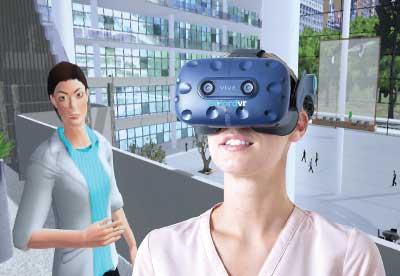Exposure-based behavioral therapies—which involve patients facing their fears—are known to be effective at reducing anxiety, but they can be discomforting to patients. With virtual reality (VR), these fearful environments can be experienced in a safe and controlled setting.
A clinical study published in the August issue of Lancet Psychiatry demonstrates the potential of one such VR program, called “Now I Can Do Heights,” to help people overcome acrophobia (a fear of heights). The program provides users with a series of virtual activities, guided by a digitally rendered coach, or avatar. It was created by a team at the University of Oxford.
There are potential advantages of VR-based phobia therapies, Daniel Freeman, Ph.D., a professor of psychiatry at Oxford, and colleagues wrote. For one, a person using VR can instantly travel to a variety of fear-inducing settings. These virtual environments also produce less psychological stress, since the user knows it’s a simulation, he said.
“We need greater numbers of skilled therapists not fewer, but there are far too many people who would really benefit from the very best psychological therapies who do not receive them,” Freeman, who is also a practicing clinical psychologist, told Psychiatric News. VR could offer a cost-effective way to reach many of these people, he said. (A set of VR headsets and VR-compatible computers can be purchased for about $1,000.)
To evaluate the effectiveness of “Now I Can Do Heights,” Freeman and colleagues enrolled 100 people with clinically diagnosed acrophobia. All participants scored higher than 29 on the Heights Interpretation Questionnaire (HIQ), which the researchers considered as the threshold indicating a moderate fear of heights. The average HIQ scores for participants were about 53.
Half the participants underwent individual VR therapy sessions at the offices of Oxford VR (an Oxford spinout company that designed the simulation); the other half received no intervention but were offered the VR therapy once the study ended.
The VR therapy involved six 30-minute sessions over two weeks. In the first session, the virtual coach provided background information about acrophobia and how to treat it from a cognitive perspective. Cognitive treatment entails having phobia patients develop memories of safety in stressful environments that counteract their existing fear associations.
The remaining sessions had the participant tour a virtual 10-story office complex and take part in activities to break down their fears while the digital coach provided empathic encouragement, repeated key learning points, and sought feedback on whether the participant felt safer than before. As the program advanced, the activities became more challenging. Some of the virtual activities included walking out on a high platform over the building lobby or rescuing a cat from a tree.
Though the coaching was done entirely by the avatar, a graduate student was on hand for all sessions to help participants put on the VR headsets and monitor participant safety.
The VR intervention proved well accepted. Of the 47 people assigned to the VR group who attended at least one session, 44 completed all six sessions. Two of the three participants who did not complete all the sessions said they stopped attending when they became too difficult, while the third did not have time.
After two weeks, the mean change in HIQ total score was a 24.5-point reduction in patients in the VR group compared with a 1.2-point reduction among those participants who did not receive the VR therapy. At a two-week follow-up visit, 34 of the 49 VR participants had HIQ scores of 29 or lower, compared with no participants in the control group.
“Afterward people even found they could go to places that they wouldn’t have imagined possible,” including up mountains and across rope bridges, Freeman said.
Skip Rizzo, Ph.D., director for medical virtual reality at the University of Southern California Institute for Creative Technologies, told Psychiatric News that any study looking to increase access to behavioral therapies should be lauded. However, while it may seem innocuous to provide people with a home-based therapy, he noted that therapist-free trauma therapy comes with risks.
“In regard to replacing therapists, I think it’s best to tread slowly and thoughtfully,” he continued. “There are risks to allowing people to self-diagnose an illness and then self-select a treatment.
“There is definitely a place for virtual reality in clinical psychology, but these programs should be integrated with a therapist, who can conduct a thoughtful diagnosis and treatment plan.”
This study was funded by Oxford VR and the National Institute for Health Research. In addition to his professorship, Freeman is the chief clinical officer at Oxford VR. ■
“Automated Psychological Therapy Using Immersive Virtual Reality for Treatment of Fear of Heights: A Single-Blind, Parallel-Group, Randomised Controlled Trial” can be accessed
here.



